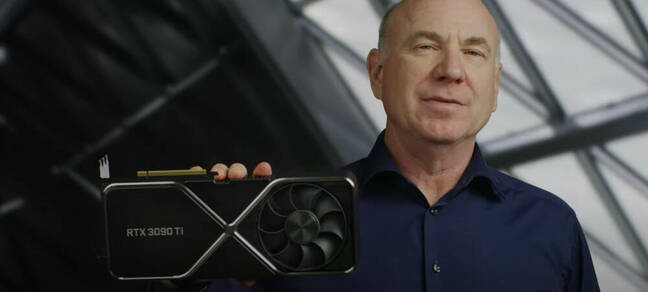This article is more than 1 year old
How can we push more chips, Nvidia thinks: Ah yes, free 3D metaverse-slash-omniverse tools for creators
Plus teases 'monster' RTX 3090 Ti graphics chip
Nvidia thinks the metaverse, omniverse, or whatever you want to call it will be a vast interconnected galaxy of 3D worlds, and wants you to use its tools to build that animated universe – tied to its RTX GPUs, natch.
The chip designer has a marketplace of sorts called Nvidia Studio, which offers or promotes selected hardware and software to create these virtual environments, all accelerated by the animation, simulation, and AI engines in Nv's silicon. Studio provides drivers and SDKs that applications from, say, Adobe and Autodesk can use to build and simulate this metaverse content on its hardware, said Nvidia senior vice president, Jeff Fisher, who bears an uncanny resemblance to businessman Kevin O'Leary of Shark Tank fame.
For CES this week, Nvidia expanded Studio with an update to Canvas, which can form landscape backgrounds from simple sketches.
Nv also said its metaverse creation tool called Omniverse is now out of beta and available for free for individual creators and artists with RTX GPUs.
Omniverse is not just the name of the software suite: it's Nvidia's catch-all term for the hardware and software technologies it is putting together for the metaverse. It includes connectors, applications and cloud services on which creators can create, render and simulate 3D content.
- Nvidia says its SmartNICs sizzled to world record storage schlepping status
- Nvidia CEO Huang jointly files patent for software tech in the metaverse
- GPU makers increasingly disengage from crypto miners
- AMD claims up to 24 hours of laptop battery life with its latest Ryzen 6000 silicon
Omniverse can be used by individuals to create simple avatars, or by multiple engineers collaborating to create and simulate complex machinery before a physical version is released, we're told.
Nvidia is backing the open-source USD file format, which was originally created by Pixar, as a linchpin to build a collaborative metaverse. Nvidia has described USD as as the "HTML of 3D."
Omniverse brings together apps in a virtual space to cut down time required on steps like creation, texturing and scene creation, which is typically a sequential process.
Nvidia also made a bunch of other Omniverse-related announcements, including Nucleus Cloud, a one-click cloud-based tool for animators to collaborate on 3D scene creation. Omniverse also has new marketplaces with companies like Sketchfab and CG Trader putting up 3D assets that can be used for free.
Speaking of GPUs, the company announced the RTX 3050 for desktops, which will be available by the end of the month for $249. It has 8GB of GDDR6 memory. Also, laptops with the GeForce RTX 3070 Ti laptop GPU will be available next month.
Nvidia also said it improved a slate of MaxQ technologies so GPUs work better with CPUs and other chips in PCs to boost gaming performance while reducing power consumption. For example, one technology in the MaxQ 4.0 framework is Battery Boost 2.0, which uses artificial intelligence to improve gaming and battery life.
"AI controls the whole platform, finding the optimal balance of GPU and CPU power usage, battery discharge, image quality and frame rates all in real time. The result is great playability on battery, with up to 70 per cent more battery life," Fisher said.
Fisher, at the end of his CES keynote, previewed the next "monster" GPU, the RTX 3090 Ti, followed by a bunch of numbers: 40 shader teraFLOPS, 78 RT teraFLOPS, 320 tensor teraFLOPS, and 24 gigabytes of 21 gigabit-per-second G6X memory. More details on the GPU will come later this month, he promised. ®

